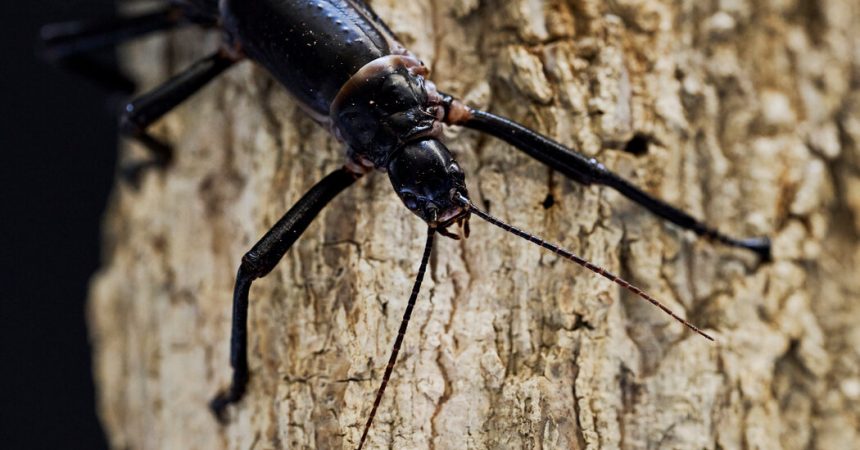The feisty Lord Howe Island stick insect crawling on the gloved hand of Kyle Kassel, a keeper at the San Diego Zoo, had no idea that he shouldn’t exist. The intrepid insect, nicknamed a tree lobster because some grow to eight inches, seemed determined to prevent me from snapping a good picture as he raced about Mr. Kassel’s hands like a dog with the zoomies.
This rambunctious stick bug has also been called “the world’s rarest invertebrate” after it was driven nearly to extinction. But here he was in the zoo’s McKinney Family Invertebrate Propagation Center, undeniable evidence that an international effort, led by the Melbourne Zoo in Australia, may manage to bring the Lord Howe Islander back from the brink.
Insects receive far less conservation attention than their charismatic vertebrate cousins, like tigers and pandas. But they and other invertebrates are the spineless backbones of ecosystems, playing critical roles as pollinators, predators, prey and decomposers.
Conservation breeding, including efforts to raise insects like the Lord Howes in captivity at big zoos like San Diego and Melbourne, could allow humanity to save declining populations and restore the vital functions these animals fulfill.
But doing so requires that the animals have a livable habitat to return to — and that the humans living there want them back in the first place.
The Lord Howe Island stick insect is not as flashy as other members of the insect order Phasmatodea. Sporting a mostly brown color palette, these insects take the “stick” part of their name seriously. But what this phasmid lacks in gaudy wings or vibrant colors it makes up for with a simple, down-to-earth charm.
The island it was named after sits about 370 miles east of mainland Australia and was discovered in 1788 by a British naval officer, Henry Lidgbird Ball. Human settlement followed in 1834. In 1918, a trading ship accidentally released stowaway rats, and things quickly went downhill for the island’s native life. By as early as 1921, the rats wiped out the island’s stick insects.
Hope that the bugs were still alive began to swirl in 1964, after a rock climber discovered a recently dead one on Ball’s Pyramid, a volcanic spit of land that juts aggressively out of the ocean about 14 miles southeast of Lord Howe Island.
“It’s quite a stark landscape,” said Kate Pearce, life sciences manager for invertebrates at the Melbourne Zoo. “There’s not a lot of soil on it.”
Subsequent efforts to find living stick insects on Ball’s Pyramid were unsuccessful until 2001, when a search party hiked up the pyramid at night and found two females in a small tea tree. The entire living population of tree lobsters, about 24 individuals at the time, was there clinging to life on the edge of the pyramid.
Australian researchers immediately planned a rescue mission. In 2003, the Lord Howe Island Board, in partnership with the government of New South Wales, sent scientists to collect pairs of stick insects from Ball’s Pyramid and ship them to experts who could breed them.
“They chose Melbourne Zoo because of our experience with invertebrates,” said Ms. Pearce, who has overseen the zoo’s stick insect program since 2011. The Melbourne team learned to care for their duo, named Adam and Eve, through high-stakes trial and error.
Ms. Pearce’s predecessor, Patrick Honan, stayed overnight with Adam and Eve to monitor their well-being. Eve was reluctant to lay eggs; eventually, Ms. Pearce said, “she did become quite unwell.”
Mr. Honan mixed a “magical elixir” of sugar, calcium and ground-up tea-tree leaves, and then carefully dripped the concoction into Eve’s mouth. After the keepers placed a sand tray into her enclosure, she happily laid eggs in it. Most stick insects drop eggs onto the ground while hanging from a branch; Lord Howe Island stick insects do this too, but for some reason, Eve preferred sand.
These early struggles paid off, as the Melbourne Zoo now maintains a population of around 500 Lord Howe Island stick insects. In 2017 it brought another female from Ball’s Pyramid (named Vanessa after the rock climber who found her) to diversify the captive gene pool.
The San Diego Zoo has had its own struggles. Melbourne sent it a batch of eggs in 2012, but around 20 percent hatched, and none of those hatchlings survived.
For the second attempt, in 2015, Paige Howorth, an invertebrate zoologist, went to pick up the eggs herself. “I was expecting Qantas to roll out the red carpet for me,” she joked. But that population of stick insects ultimately petered out too.
The third try, a shipment of 600 eggs in 2022, was the charm, leading to the zoo’s current count of at least 400 individuals.
At their home in San Diego, the Lord Howe Island stick insects live cushier lives than on Ball’s Pyramid. Their room’s climate mimics their native island, complete with a fan providing a constant gentle breeze. A team of 13 keepers, led by Dr. Howorth, tends to the far-flung phasmids, along with separately housed tarantulas, mantises, beetles, crickets and horseshoe crabs. The team’s mascot is a coconut crab named Kenny, who during my recent visit was busy molting under the soil of his enclosure.
The first major invertebrate conservation breeding program started in 1986. A coalition of zoos collaborated with the International Union for Conservation of Nature to save a group of more than 100 tree snail species.
Partulids, like many snails, help keep their environment clean by eating fungi and dead plants. The group is spread across Polynesia, with just about every island home to unique species that look and behave differently.
“They’ve been the subject of evolutionary research for over 100 years,” said Paul Pearce-Kelly, invertebrate curator at the Zoological Society of London and a leader of the partulid program. “The snail equivalent of Darwin’s finches.”
Their fame meant people were paying attention when their numbers started to decline because of an invasive predator called the rosy wolfsnail.
Efforts to release the gastropods back into their native habitat started in earnest in 2015, and have continued ever since; in April 2023, for example, the team released more than 5,000 snails on the French Polynesian islands of Tahiti and Mo’orea. More than 25,000 captive-bred partulid snails have been let loose across the Pacific islands into areas not yet invaded by the wolfsnail, with the hopes that they’ll survive long enough to breed and produce self-sustaining populations.
Rearing invertebrates is much cheaper than raising pandas or tigers, but it’s not a walk in the park. Despite decades of effort, some partulid snails still will not tolerate being raised in captivity. And keeping hundreds of animals means hundreds of hungry mouths to feed; the Melbourne Zoo grows “several thousand plants just for Lord Howe Island stick insects,” Ms. Pearce said.
Mr. Kassel, the San Diego Zoo keeper, called the phasmids “ravenous.” Large zoos in warm climates like Melbourne or San Diego can meet this demand for foliage, but many others cannot.
The captive environment itself can also present problems. Starting a population from a few individuals leads to inbreeding, which can lead to shorter life spans or difficulty reproducing. Disease can also spread rapidly in close quarters; from 2013 to 2015, Melbourne contended with two bacterial outbreaks that swept through the stick insects.
And when they are kept in confinement long enough, the fast-paced reproduction of many invertebrates enables them to literally evolve before our eyes. A 2021 study found that the Melbourne stick insects have evolved smaller eyes and fewer smell receptors over time, which the study’s authors warn could hurt their ability to survive in the wild.
Reintroducing invertebrates to the wild poses its own difficulties.
Cristina Venables lives on Lord Howe Island and leads the local government’s environment and world heritage team. In addition to caring for a captive colony of stick insects, she is preparing the island — and the islanders — for the potential return of the tree lobster to its landscape.
In 2019, the authorities executed a plan to rid the island of its invasive rats. They seem to have been successful: No live rats have been seen there since August 2021. But even though the animal responsible for the stick insect’s decline has been eradicated, “I won’t say that we are going to reintroduce the phasmids,” Ms. Venables said. “We need to consult and bring the community along with us.”
Though many of the island’s 445 inhabitants are fiercely proud of their home and its native wildlife, others are concerned about what life with the insects might be like.
“There’s nobody alive who has ever lived with phasmids anymore on the island,” Ms. Venables said. So stories about them noisily crawling on roofs or stripping trees of their leaves “can take on a life of their own.”
Ms. Venables’s focus is on educating the locals about the stick insects and the environmental benefits they provide, such as being a food source for native birds and leaving waste that helps fertilize the soil.
Although the captive population she manages is not on display, Ms. Venables plans to invite the community to visit their potential new neighbors and even help out with caring for them “so they can see what the phasmids are about.”
So what are the Lord Howe Island bugs about? I got a hint at the San Diego Zoo’s Spineless Marvels exhibit, where some of the stick insects are on display. There, I saw one of the rarest invertebrates on Earth proudly standing front and center, quiet and still, with a piece of poop stuck to his head.






